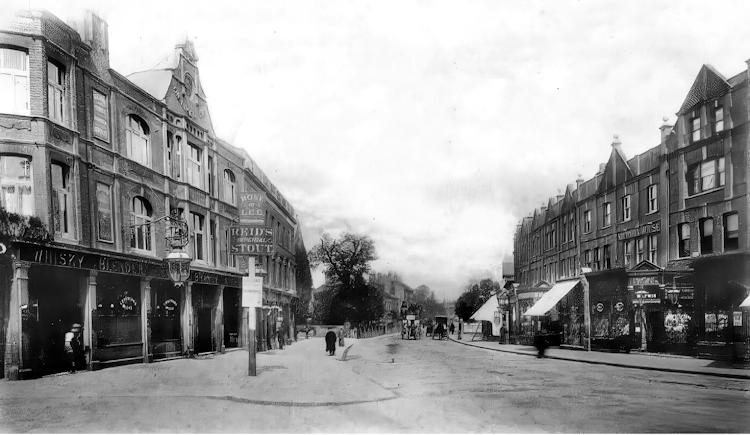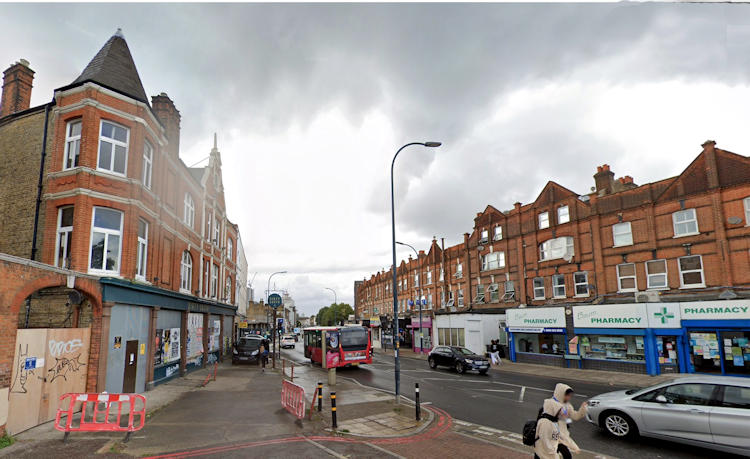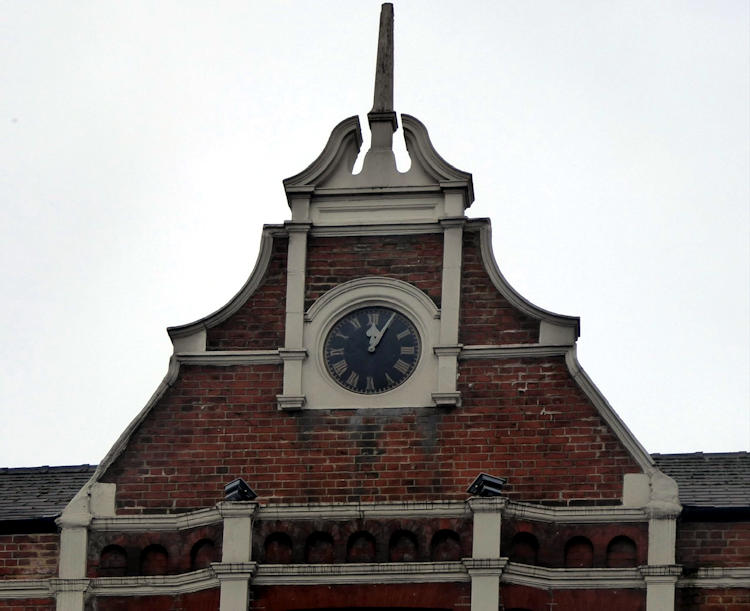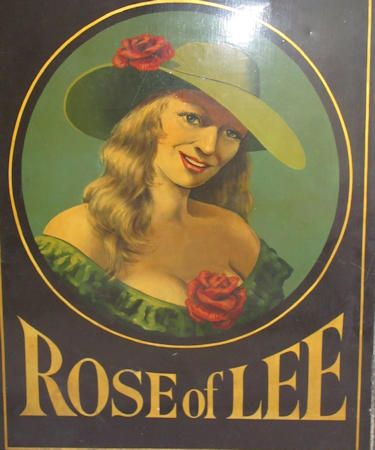|
Information taken from
https://runner500.wordpress.com/2021 accessed 2 October 2023.
On a bend in Lee High Road going towards Lewisham from Lee Green
an attractive late Victorian pub dominates. Currently badged the "Dirty
South," it has been empty since March 2020, seemingly a victim
of COVID-19. It has some lovely architectural detail (including the
original brass clock) and a fascinating history, most of it when
called the "Rose of Lee."
It is a pub that seems to have first opened its doors in 1859
with a licence granted to William Baker. The area around had started
to be developed in earnest from the 1850s after the opening of
Lewisham station in 1849, although there was earlier ribbon
development along Lee High Road. The area that is now the Mercator
Estate was developed in the 1850s and a Baptist chapel opened on the
corner of Eastdown Park in 1854, along with Christ Church in Lee
Park the same year. With the spiritual needs being met it is not
surprising that there would be an attempt to meet the drinking
requirements of the relatively wealthy locals.
The early years seemed to be a struggle for licences and Henry
Taunton took over in 1861. By the autumn of the following year,
possibly before, John Maywood Lee was there and had applied
unsuccessfully for a music and dancing licence. The same application
was repeated a year latter with a sympathetic local press noting a
‘strong case’ and no opposition, but the magistrate was
unsympathetic.
Lee moved on by July 1864 with the 25 year old William Hart
Wildee taking on the licence. He had previously had the licence of
The "Victory" in Kingsland Road from 1861, which he seems to have
inherited from his father.
Wildee seems to have wanted to make better use of the large space
that the "Rose of Lee" offered – attempting to generate more regular
income from the function room above. It was described in the press
as a “ventilated room 75’ by 26’ ft (24 x 9 m) suitable for ‘first
rate club or society.’” Its availability for excursion parties and
bean feasts was noted too.
The magistrates seemed to take up the offer; in an era where few
public buildings courts were often held in hotels and larger public
houses, as we saw with the "Green
Man" on Blackheath in relation to the Blackheath Pedestrian. The
"Rose of Lee" was also regularly used for auctions – such as one for
a range of building materials in June 1868.
William Wildee attempted unsuccessfully to sell the lease in 1866
– the "Rose of Lee" was described as ‘a modern structure and replete
with every convenience for carrying out a profitable trade’. The
implication seeming to be that while there was potential, money
wasn’t being made.
Wildee’s tenure didn’t last much longer as it was cut short by
his death in early 1867 at the "Rose of Lee." His assets which
included the lease passed to his wife, Harriet. While she took over
the licence she sold up to George Taylor in the autumn of 1867 – he
was to be 6th name above the door in 8 years.
George Taylor’s tenure ended with eviction, although this seems
to have been something of a formality as he was reported to have
abandoned the pub and fled the country – perhaps with large debts
and wanting to avoid the debtors’ prison. The "Rose of Lee" was left
empty for a ‘considerable period’ before a new licensee arrived –
the licence was granted to either someone called John Steib or by
John Scott, an experienced publican who had run two pubs before for
a total of 10 years, depending on the newspaper.
John Steib was certainly a licensee there as he was replaced by
James Philip Janes in 1872. Janes would have been 21 when he took
over the tenancy, he too struggled and by 1873 James Martin’s name
was on the brass plate over the door. By early 1874 William
Edgington was granted the licence after pub had been ‘closed’ by the
late tenant, presumably Martin. Edgington’s tenure was even shorter,
Walter Pool was the new landlord by September 1874
The "Rose of Lee" was becoming a graveyard for publicans some who
had success elsewhere – James Janes did so elsewhere in Woolwich and
New Cross and by the 1881 census he was living on Lewisham High
Street and described as a ‘Retired Licensed Victualler’ and
employing three servants.
Pool seemed to make a little more of go lasting until around 1879
before Edward Slater took over the licence. Slater, from Wednesbury
in the Black Country, was there when the 1881 census enumerators
called, along with two nieces and a barman. The licensee and owner
by 1886 was Frank Wilson though.
While music and dancing licences had been rejected in the 1860s,
they had certainly been granted by the 1885. One of the relatively
regular users of rooms there were Lewisham Hare and Hounds, a
forerunner of Kent AC. The club had a handicapped race from their
Hither Green Hall base (listed as Patches Lane, which seems to have
been part of Hither Green Lane) with ‘smoking concert’ at the "Rose
of Lee" afterwards. It was used by other sports clubs for similar
purposes, including Blackheath and Lee Cricket Club.
Frank Wilson had taken over both the licence and the ownership of
the "Rose of Lee" probably from around 1883 when one of his children
was born in Lee. The family had spent time in Aden (now Yemen)
before that. In the 1891 census Frank was there with his wife,
Alice, six children and a barmaid – Ada Sidery. Ada was a local
woman and was one of at least 12 children of the builder William
Sidery and had grown up 100 metres down Lee High Road (next door to
the Baptist Chapel, later site of Fry’s and Penfolds parts and
servicing).
Frank Wilson sold up to Thomas Henry Cook in 1896; Cook seems to
have been behind the rebuilding of the "Rose of Lee." Several
prominent local pubs had been rebuilt in the late 1880s and 1890s –
notably the "Sultan," close to Lewisham, the "Woodman" further up
Lee High Road, along with the Old and New Tigers Head pubs at Lee
Green. Plans were submitted to the Parish surveyor in 1897. However,
it wasn’t until 1900 when plans were approved by local magistrates.
No photographs seem to exist of the original "Rose of Lee," but
the changes are obvious from the ‘footprint’ of the pub from 1863
(left) and 1914 (right) Ordnance Survey maps.
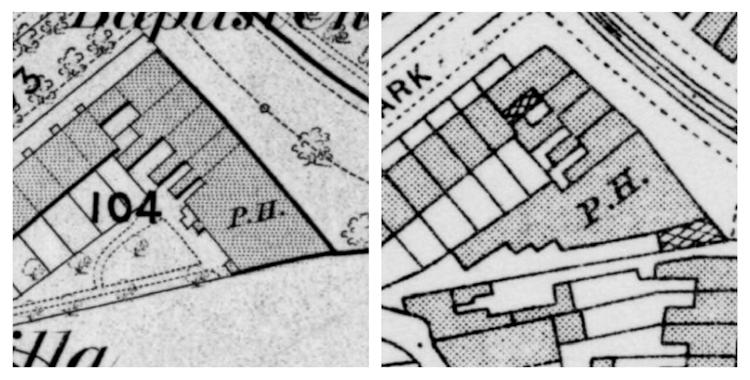
The changes seem to have enabled the pub to have a billiards club
which saw regular exhibition matches, the were appearances from some
of the well-known professional players of the day. In 1906 this
included Bert Elphick who was to become the Billiards
Professionals’ Association Champion a few years later and Walter
Lovejoy who had recently turned professional after winning the
amateur championship in 1904.
Other clubs and societies met there too – Lee Rovers Cycle Club
had already moved there from the alcohol free Jubilee Coffee Tavern
near Lee Green. With the Lee Excelsior Musical Society meeting
there as well. The pub was home too to several Masonic Lodges,
including the Lee Lodge of Instruction which had links to another
lodge at Eltham Palace.
Cook was born in 1861 in the City and in the 1901 census was listed
as being at the "Rose of Lee" living with his wife, Maud, four
children, some extended family, two servants and four bar staff.
Unless Thomas Cook was living way beyond his means, it seemed that
the pub was a thriving business and had moved way beyond the trials
and tribulations of his predecessors.
Cook was fined in 1903 for selling alcohol to a drunk, despite
evidence to the contrary but the magistrates believed the police.
Cook must have moved on soon after as the 1905 Kelly’s Directory
listed a Hugh William Shannon as being the landlord. Although Adrian
Bailey had taken over by the end of 1905 and like Cook,
received a fine for selling alcohol to a drunk the following year.
Bailey there until December 1909 – the date was mentioned in case
where his wife, Emily, was seeking divorce, citing cruelty. These
were allegations that he denied, and the petition was dismissed. By the end of the war they were divorced though, Emily had
moved in with a former regular at the "Rose of Lee" and Bailey, then
an army Lieutenant, hired a private detective to get the evidence.
Thomas Robinson there in 1911 and is listed in the census with his
wife, Edith, two young children, two servants, three bar staff and a
boarder. The Robinsons had moved on by 1916 and Kelly’s listed
George Poole as the man pulling pints.
George Poole and was to have his name in brass over the door until
around the end of World War 2. Other than his 1939 Register entry,
anything more of George’s life has proved difficult to track down –
he was listed there as being born in 1872 and in 1939 was living
there with his wife, Frances, a couple of bar staff and a cook.
By the 1945 Kelly’s Directory, the pub was listed as being run by
Norriss Brothers, Caterers – who are listed until the early 1950s,
after which the Directory doesn’t name who was there.
The pub was run by Alice and Len Dwan in the late 60s early 70s. Len
had been born in Bermondsey in 1928. He was living in Mayflower
Street in Rotherhithe in 1939, and seems to have been late being xx.
He married Alice (née Britton) in Bermondsey in 1952, it seemed to
be her second marriage. She Alice was born in Bermondsey in 1929 and
was living in Surrey Quays in 1939.
Alice used to cook large joints of meat for bar food sandwiches. She
died, relatively young, in Southwark in 1990 with Len moving to
Orpington where he passed away in 2014.
By the 1970s it was at least in part a music venue with bands
playing regularly, its greatest claim to fame from this era was the
first gig of Kate Bush in March 1977. The set list included a lot of
covers including ‘Come Together’, ‘I Heard It Through The
Grapevine’, ‘Tracks Of My Tears’, but some of her own songs
including ‘James And The Cold Gun’, ‘Saxophone Song’ and ‘Them Heavy
People’ which all appeared on her debut album.
There were lots of fond memories of the pub in the 1970s and 1980s
from a Facebook thread – the upstairs room used for wedding
receptions, a landlord called Austin from the early 1980s who
continued the tradition of live music, soul and R&B nights on
Sundays, and, of course, the odd lock in – although how on earth
that would have been hidden with the frontage, goodness knows….
The next landlord seems to have been Ron Miles around 1982, under
the ownership of the Host Group (part of Grand Metropolitan). The
music continued, a gym was set up in a room upstairs, and there were
plans for a night club. However, Host in the end changed the "Rose of
Lee" into a Sports Bar, Ron helped set this up before moving on
around 1985.
It later became Hobgoblin. It never seemed terribly inviting, a bar
dominated by TV screens with a sparse number of drinkers looking out
through the large windows. The landlords from the 1980s and beyond
included Vickie & Steven Hill, Tony Coffey and Colin Taylor who ran
the pub between 2001 and 2004.
From around 2004, the "Rose of Lee" re-invented itself as a rock and
indie music venue, again badged as the Dirty South. It was a venue
which attracted a younger audience, it always seemed busy around the
weekend with DJ sets, which included the likes of Tim Burgess from
the Charlatans and Terry Hall of the Specials.
There were lots of live acts too – this included some significant
names from the era as two snapshots in time from Google StreetView
in 2008 and 2009 note – posters outside included gigs for Bloc
Party, Bombay Bicycle Club, the Levellers, The Yards (a band that
evolved from The Seahorses), Domino Bones (a band that featured Bez
from the Happy Mondays) and Babyshambles, filmed below – warning the
music is loud and of not great sound quality. Alabama 3 also played
there in 2010.
From around this time the upper floors started to be used for
temporary housing hostel of various types – known as Rose House.
The pub was ransacked during the summer riots of 2011; while there
main damage was to the windows at the front, it was enough to see
the pub remained shut for around 5 years, with a full re-launch in
2017. It was a different clientele and age group it was aiming at –
no longer primarily a music venue rather it seemed to have modelled
itself on the same demographic as the seemingly successful Station
Hotel on Staplehurst Road.
They offered a variety of fayre with an emphasis on food but music
continued with jazz evenings and DJ sets, along with quiz nights and
football on the TV. The shutters went up at the beginning of the
first COVID-19 lockdown and never seemed to come off. Its website is
no more, and the Facebook page has been silent since 7 March 2020.
At the time of writing in early 2021, the building is squatted and
with metal grilles over the windows at the front It is a forlorn
looking sight – it is owned by Wellington, a company controlled by
the ultra-rich Reuben Brothers, its future, like much of the pub
sector, appears very uncertain in the current environment. A little
protection was added in late 2021 when it was granted Asset of
Community Value by the Council. This means that if it ever went on
the market a group of local people could get together to put in a
bid for it, and go on to open and run the venue for the benefit of
the community.
If you worked there or drank there, tell your story, who were the
characters who propped up the bar, the landlord, the staff, the
atmosphere, the memorable nights, the particular celebrations that
were held there, memories of the friends, the beers. Post them below
(you can use your Facebook or Twitter login – or via Facebook (if
you found the post via here) – if it is you first comment ‘here’,
you will have to wait for ti to be ‘moderated’. I will update the
post with comments. Anything libellous will get deleted here & no
doubt on the Facebook Group pages.
A massive thank you to Colin Taylor, landlord at the pub in the
early 2000s and with much longer connections to the pub for his
input – filling in some details and correcting me on a few things.
|
